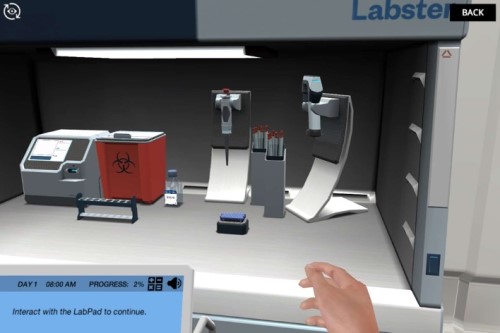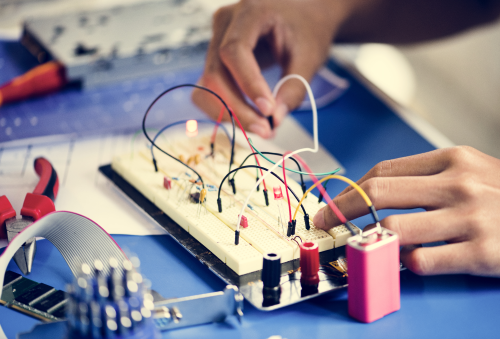
Labs: Virtual, Remote, and In-A-Box
Engineers are doers. They build objects, manipulate information, and analyze natural forces to improve human life. To do this, engineers must have knowledge of their domain based not only in theory, but also in “hands-on” application. In engineering education, this typically comes in the form of laboratory assignments (labs) where students go to a physical space and use specialized equipment. But how do labs work in an online course?
Even online courses can include elements of real, hands-on application of concepts. But like any lab—in-person or otherwise—it involves some logistics and a little creativity. Depending on the nature of a course’s topic, online labs can take many forms. Typically, though, there are three different ways of implementing labs in an online course: virtual, remote, and in-a-box.
Virtual Labs
Virtual labs involve the use of a virtual environment that students interact with or manipulate to simulate a real-world, physical laboratory environment. Often the virtual nature of these labs is out of necessity, to enable students to perform applied lab work from a distance. However, sometimes a lab is virtual because it provides a safer space to conduct an experiment than a physical space would. Additionally, virtual labs allow students to practice lab skills repeatedly since they often can be used many times.

In the Applied Biomedical Engineering (ABE) program, Dr. Arielle Drummond and Matt Shaeffer are part of the instructional team that teach 585.725: Biomedical Engineering Practice and Innovation Lab (BEPI). BEPI is an online, lab-based course that consists of multiple lab assignments and typically has an in-person lab component over two weekends. The course has been adapted to also be available fully-online without an in-person requirement. Doing so requires implementing a combination of lab components, one of which is a virtual lab simulation through Labster. Labster offers a variety of virtual science, medicine, and engineering labs in their virtual environment for students to interact with through a web browser. There are many other virtual lab vendors which provide similar kinds of virtual lab environments catering to science, medicine, and engineering topics. These typically have per-student seat licenses which allow you to incorporate them into the materials costs for your course. In the BEPI course, Drummond and Shaeffer included a cell culturing lab to give students an opportunity to experience a wet laboratory environment. This kind of experience, even while not physically hands-on, is still beneficial to building confidence, familiarity, and practical skills with the tools and techniques involved in a specialized laboratory environment students may encounter in another course or in their professional careers.

In the full-time Materials Science and Engineering program, Dr. Orla Wilson teaches 510.428: Materials Science Laboratory I for undergraduates. During the pivot to remote teaching, Wilson reimagined the lab activities and utilized a Microsoft Hololens 2 virtual reality (VR) headset to livestream experiments for students. With the Hololens headset, Wilson could view the Microsoft Teams meeting room and pull up lab documents all while interacting with physical equipment for the experiment. Through the Teams Meeting livestream, students could see what Wilson saw, including her manipulations of the equipment, digital documents pulled up for reference, and a collaborative whiteboard they could interact with. When some students were able to return to campus, the labs evolved into having small student groups where one student in the classroom would wear the Hololens and livestream the experiments for their remote groupmates who would direct the headset-wearer on what to do.
Jason Crossland teaches two lab-based courses in the Cybersecurity program, 695.643: Introduction to Ethical Hacking and 695.642: Intrusion Detection, which are both designed around nine different programming labs. The labs utilize a virtual machine (VM), which along with specific lab files used to set up and run each lab, students install on their computers. In the labs, they execute real-world, simulated tasks aligned with the course topics. For the VM environment, students can choose between Ubuntu or Oracle Virtual Box. JHU also provides access for all students, faculty, and staff to Hopkins MyCloud, which is a Windows 10 virtual desktop. This can be especially useful if students need to run software that is PC-only. For more VM options, refer to our guide on Virtual Machines and Computing Options at WSE.
Remote Labs
Remote labs are similar to virtual labs in that students access and interact with the lab from their homes via a computer and internet connection. However, in remote labs, students interact with real, physical equipment in a campus laboratory that is specially set up for remote use. It can require significant upfront planning and logistics work to set equipment up for remote use, but for courses and programs where specialized equipment use is important, the effort is essential.
Along with the virtual lab elements of using a Hololens headset, Wilson’s Materials Science Laboratory course also incorporated a remotely-controlled microscope which students could manipulate to study the structure of different materials. Once the sample was placed on the microscope, students could control the microscope to move the stage, change focus and objectives, and save images as they worked.
Jeff Houser’s course 525.654 Communications Circuits Laboratory in the Electrical and Computer Engineering (ECE) program is an online laboratory course that extends the material presented in 525.616: Communications Systems Engineering. Students perform laboratory exercises each week by remotely-controlling high-end test and measurement equipment located on campus. They access the equipment through a web browser connection to a local computer that hosts LabVIEW software to control the equipment. Lab time must be reserved in advance since equipment can only be accessed by a single user at a time. During their reserved time, students can interact with the digitized equipment interface which has been developed to include a subset of the functionality of each instrument. The initial infrastructure development for this course was significant and requires regular software maintenance, but giving students the opportunity for hands-on experience with real equipment is critical for the ECE program.
Lab-In-A-Box
Labs-in-a-box are the most similar to physical laboratory work, as they allow students to perform experiments at home using materials and equipment that are shipped to them. While this method may mean compromising the sophistication of the equipment students use, many engineering lab assignments include components that can be easily shipped and set up at home. Depending on the number of students and materials needed for a lab, lab kits can take the form of curated shopping lists from online retailers, boxes packed and shipped by an instructor, or using deliveries from specialized external businesses.

The ABE BEPI course also utilizes lab-in-a-box components. The instructional staff work with a vendor, Aquaphoenix, to coordinate the purchase, assembly, and shipment of lab kits to students which contain various lab components such as a breadboard, Arduino, and pulse oximeter. The course’s EKG lab, taught by Drs. Anil Maybhate and Ethan Nyberg, has students use circuit components, a breadboard, electrodes, and an Arduino device to create a basic EKG monitor and recording of their EKG. After the EKG lab is complete, students choose to extend their work for extra credit by altering the circuit to create an EMG that measures muscle electrical signals. To help students succeed, the instructors provide detailed lab instructions, video lectures, and Troubleshooting Sessions (similar to Office Hours) centered around the lab assignment.
Keith Newlander’s course 525.642: FPGA Design using VHDL in the ECE program is another lab-based course designed around hands-on experience. Students program a field-programmable gate array (FPGA) which is an essential component of any modern circuit designer’s toolkit. As part of the materials for the course, students receive physical FPGA development boards and use them throughout the course to implement and test their designs. As a culminating project, students design a project using an embedded processor in VHDL on the FPGA development board that they then program in assembly language. The labs are all prescribed – the goal is told to the students and they have to work out the methods to design and implement the solution. As the labs get more complex, the design they use to solve the assignment varies and is part of the design process each student must learn to work through.
Many labs in online courses fit into one of the three types outlined here, and the different types can also be combined to create robust and realistic labs. Regardless of the approach, you can create lab assignments in online courses that provide students with hands-on experiences that mimic or even exceed those of a traditional campus laboratory. For more examples from real JHU-WSE courses, view the recordings from our 2020 lecture series that focused on labs in online and remote courses.
Keywords: Labs
